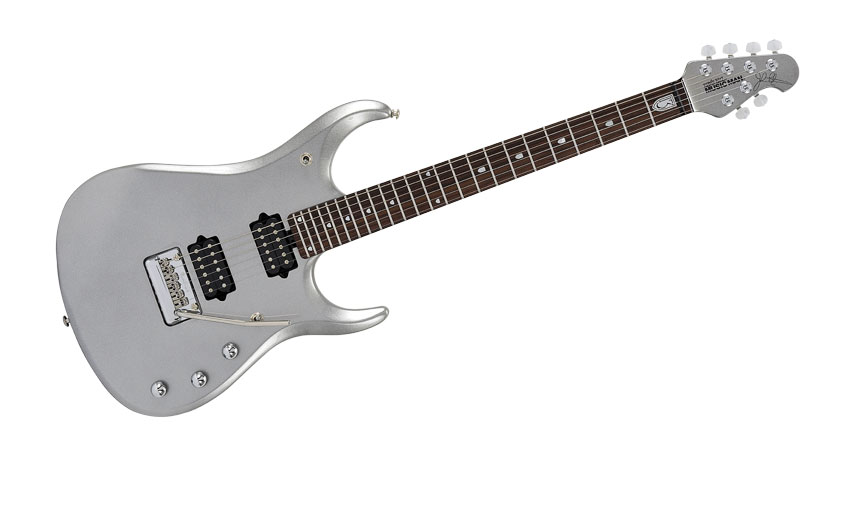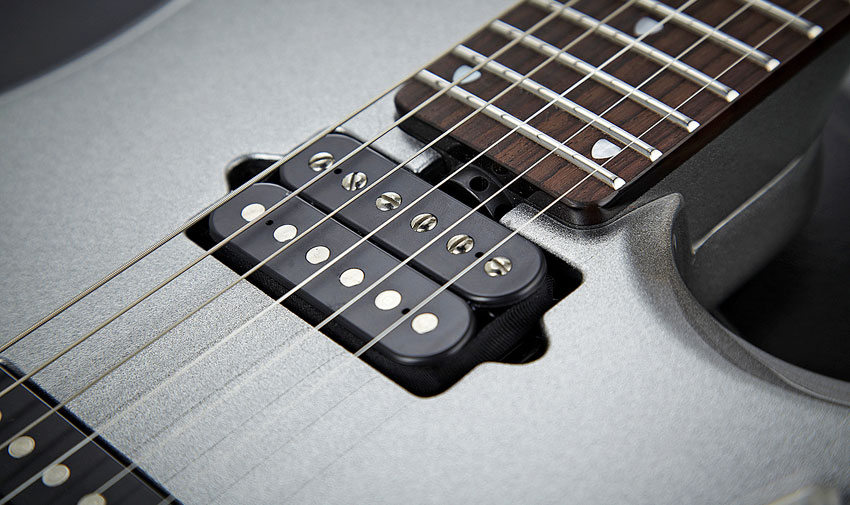MusicRadar Verdict
This latest-gen JP with new DiMarzio pickups is a great-sounding hybrid magnetic/ piezo axe. Are you man enough?
Pros
- +
Lots of power on tap, but tones are still clean and flexible. Build quality and intonation are excellent. Superb control layout.
Cons
- -
Expensive.
MusicRadar's got your back

Music Man JP13

Neck

Headstock

Bridge
John Petrucci has more signature models than any other Music Man endorsee and he added to them again last year with a new guitar, the JP13. It's his fourth high-end 'JP' model and sits alongside various signature models in the company's off-shore Sterling by Music Man range.
Build
Petrucci's new Music Man goes for a bells and whistles ride. Under faultless glam silver sparkle finish lies a basswood body with maple top and mahogany tone block and, fairly unusually, a bolt-on mahogany neck. The outline is quite Strat-like in terms of its squarish lower bouts; the chamfered-edge, skinny horns more Ibanez-like. Unsurprisingly, given its namesake, top fret access is superb.
You get pearl button locking tuners, Petrucci badge inlays on a fairly flat 432mm (17-inch) radius 'board with medium jumbo frets, which are stainless steel here. The neck shape is wide and thin in depth with almost no depth increase (19.24mm at the 1st fret to 20.1mm at the 12th) and a flat-back shallow C section.
"The DiMarzio Illuminator "next generation" pickups were designed for this guitar"
There are few modern vibratos that don't start with the Fender blueprint, but the two-post Music Man design here has solid steel saddles, a push-fit stainless steel arm and a tuning stability that is superb. In addition, the Wilkinson-looking saddles each have a piezo element and the rear is smoothly domed and chromed metal. Fundamentally, it's back routed for considerable up- as well as down-bend.
The DiMarzio Illuminator "next generation" pickups were designed for this guitar: "More expressive, dynamic and very liquid," says John. The two humbuckers are selected in standard bridge/ both/neck fashion by the three-way toggle above the volume control. However, in the up position a push-switch on the tone control changes the centre selection to the inside coils of each humbucker, in parallel.
The volume control has a gain boost (with internal trim pot level control), while the lowest of the three rotary controls is the volume for the piezo output. The shoulder- mounted three-way toggle selects magnetic/both/piezo. So far, so good.
There are two outputs mounted on the guitar's edge with three recessed trim pots for piezo mix, treble and bass. When the magnetic/stereo jack is connected, that piezo mix trim pot is disabled and with a mono cable you'll just hear the active signal from the magnetic pickups.
Want all the hottest music and gear news, reviews, deals, features and more, direct to your inbox? Sign up here.
With a stereo cable, the tip outputs the active magnetic signal, while the ring outputs the buffered piezo output - ideal for a dual amp or amp and PA setup. With a mono cable, the piezo/mono output offers a mixed mono output of the active magnetic pickups and buffered piezo. When you have two mono cables plugged in, the magnetic/stereo outputs the active magnetics; the piezo/ mono outputs the piezo.
Sounds
If you're a Dream Theater fan, you'll know that Petrucci's Music Man guitars are at the heart of his sound. Their latest eponymous album features this guitar extensively: what better demo do you need? For those of us with a broader sonic palette to fill, however, why would we play this?
"The control layout is superb; this is a very sorted guitar"
Well, it'd be the last guitar you'd take on a jazz gig, but don't think for a moment it couldn't handle it. Setting up the guitar with dual amps - acoustic and clean electric - with neck 'bucker and piezo selected, it sounds tremendous: many a modern fusioneer could use this solo or in a band.
The control layout is superb, too; this is a very sorted guitar. The piezo sound, either direct into a Line 6 StageSource or into a clean valve amp, sounds exceptionally good for acoustic-like texture. For more harmonically complex chords, the neck is subtly wider and suits thumb-behind over thumb-around left-hand positions.
It works exceeding well with a simple setup and there seems to be a lot of power on tap and with it a diffused high end. That gain boost is an excellent lead boost - or just run your sound in active mode and, trust us, you won't have any issues with lack of clarity with the heaviest gain your amp can supply.
The Petrucci model seems quite a specific signature guitar, so if John's your man then you'll certainly enjoy this. But it's also one of the finest magnetic/piezo hybrid guitars we've encountered, especially for the more progressive player. Either way, in the right context, this signature is a strikingly good guitar.
Dave Burrluck is one of the world’s most experienced guitar journalists, who started writing back in the '80s for International Musician and Recording World, co-founded The Guitar Magazine and has been the Gear Reviews Editor of Guitarist magazine for the past two decades. Along the way, Dave has been the sole author of The PRS Guitar Book and The Player's Guide to Guitar Maintenance as well as contributing to numerous other books on the electric guitar. Dave is an active gigging and recording musician and still finds time to make, repair and mod guitars, not least for Guitarist’s The Mod Squad.
